Drawings of Oak Trees in the Fall
Oaks are a group of large shade trees with an exceptionally noble character. But the true value of oak trees goes far beyond their majestic strength. Oak trees can drastically improve the quality of our outdoor lives. As an added benefit, they are also an important species in forest ecosystems.
If you have a sunny property, the summer heat can be difficult to bear. As you try to enjoy your outdoor living spaces, that heat can make for an unpleasant experience. Beyond the discomfort, excessive heat takes a toll on your wallet as well.
A house in full sun requires more energy to run air conditioning systems in the hotter months.
If this is a problem for you, an oak tree is what you need. By combining broad leaves with wide-spreading branches, oak trees offer ample shade beneath their canopies. In the heat of summer, that cool relief is much needed.
Planting an oak tree is far from a selfish option. Since these plants are so supportive of native wildlife, planting one contributes to the health of your regional environment.
Provided you have a large yard, oak trees are an option for you. But there are several dozen oak varieties that grow in North America. Each one belongs to a specific region within the continent.
If you learn the basics of oak tree varieties and how to identify different types of oak trees, you will soon be able to spot them in the wild. You will also know which oak will grow in your landscape while gaining an appreciation for the beauty these shade trees have to offer.
What Is Special About An Oak Tree?
Planting an oak tree is a long-term investment. Most oak species are both large and slow-growing. This means it will take many years for oak trees to give shade to a broad area.
But these trees are worth the wait. Proof of this lies in the large number of oaks that grow in parks, campuses, and rural estates. Those who planted those trees long ago were wise about the value oaks would add to the landscape decades later.
Oak trees usually have large rounded canopies. These hold broad leaves that can be either deciduous or evergreen. The length and width of these leave lets them block copious amount of sunlight. This creates a cooler microclimate beneath their branches.
Consider a house that sits in full sunlight. During a heatwave, the owners will struggle to keep their rooms at a comfortable temperature. The use of air conditioners and fans will quickly increase the electric bill.
A large oak on the south side of the house will make a big difference. At maturity, that tree will cast shade on the house creating a natural cooling effect. As a result, the need for electricity-based cooling systems diminishes.
Support for Forest Species
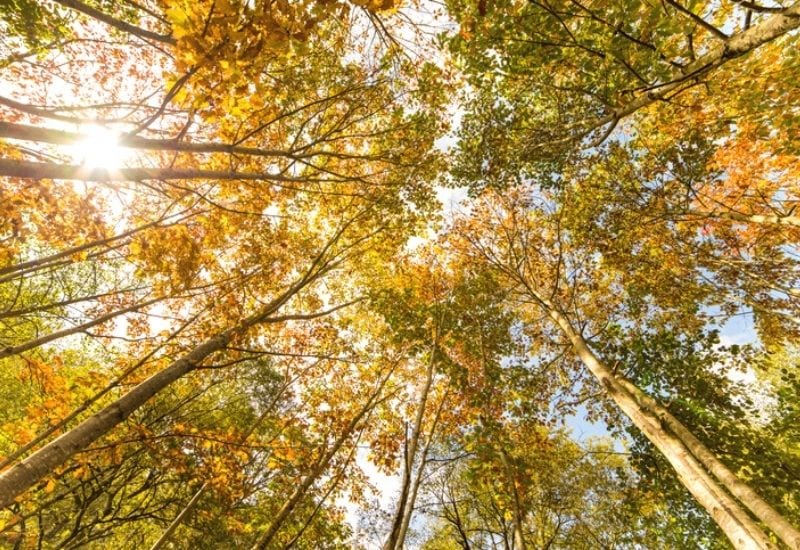
As helpful as oaks are to homeowners, they are also important for native woodland species. Numerous species rely on support from oak trees.
This support, at times, is quite literal. For example, oaks are often the tree of choice for nesting animals. Squirrels, birds, and other animals make homes in oak tree branches.
Along with this physical support, oaks are a reliable food source as well. These trees can produce copious amounts of acorns.
Mammals use these acorns as an immediate food source. They also store acorns underground to save them for seasons when other food supplies are scarce.
At times, these animals will forget where they buried their acorns. That will reduce their food supply.
But in the long run, that forgetfulness leads to more oak trees. When in the right conditions, those forgotten buried acorns will soon sprout and begin their long journey to becoming a mighty oak tree.
Oak Genera
True oaks belong to the Quercus genus. That genus is part of the beech family know as Fagaceae. These plants originate in the Northern Hemisphere.
Quercus represents a broad category containing around 600 oak species. In the United States, oaks are a dominant tree species throughout many forests. Because they've grown in such high quantities throughout the centuries, oaks are some of the most recognizable trees there are.
While all of the species in the Quercus genus have it as a part of their common name, the word "oak" is not exclusive to this group.
Plants with "oak" in their common name appear in other genera as well. As an example, stone oak is part of the Lithocarpus genus, which, like Quercus, is within the Fagaceae family.
Another exception is silver oak. The botanical name for this tree is Grevillea robusta. But unlike previously mentioned oaks, silver oak is part of the Proteaceae family rather than the beech family.
Similarly, Allocasuarina fraseriana, also known as sheoak, comes from a separate family as well. This oak belongs to the Casuarinaceae family that is common in Australia.
This is an example of the inaccuracy of common names. Despite bearing the "oak" name, silver oak, stone oak, and sheoak are not true oaks because they are not in the Quercus genus.
Common Oak Tree Varieties
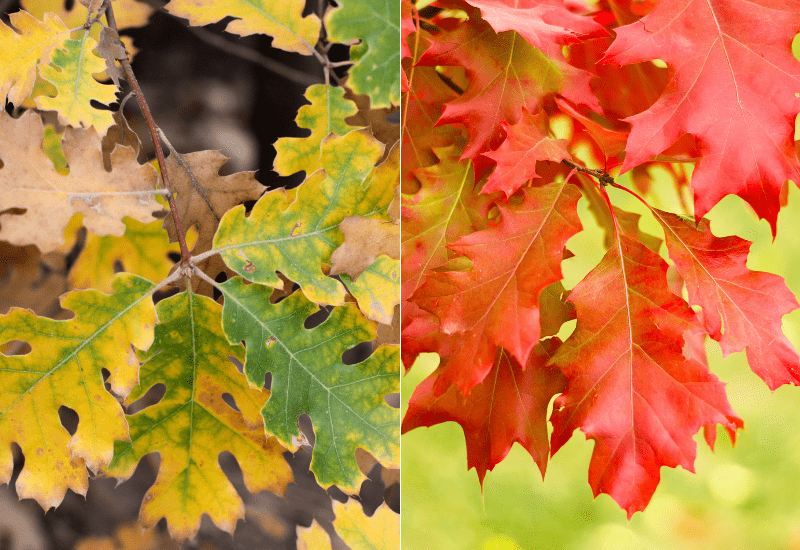
Before describing oak tree species, let's look at the two main categories of oak trees.
All oaks are a part of the white oak group or the red oak group. The two groups consist of many oak species.
Don't confuse these groupings for the individual varieties that share their name. There are species bearing the common names, white oak, and red oak. But these species are each within the broad categories of white oaks and red oaks.
To add some clarity to this, here are some prominent species in each of the two categories.
Examples of Oak Species in the White Oak Category
Examples of Oak Species in the Red Oak Category
As these are general categories. There is an equally general way for knowing which group an oak tree belongs to.
Often, oak species in the white oak category will have leaves with rounded lobes.
In contrast, oak species in the red oak category will have sharply pointed lobes on their leaves.
It can be helpful to know about these two oak groups. What is more important is understanding the characteristics of individual oak varieties.
How Do I Identify An Oak Tree?
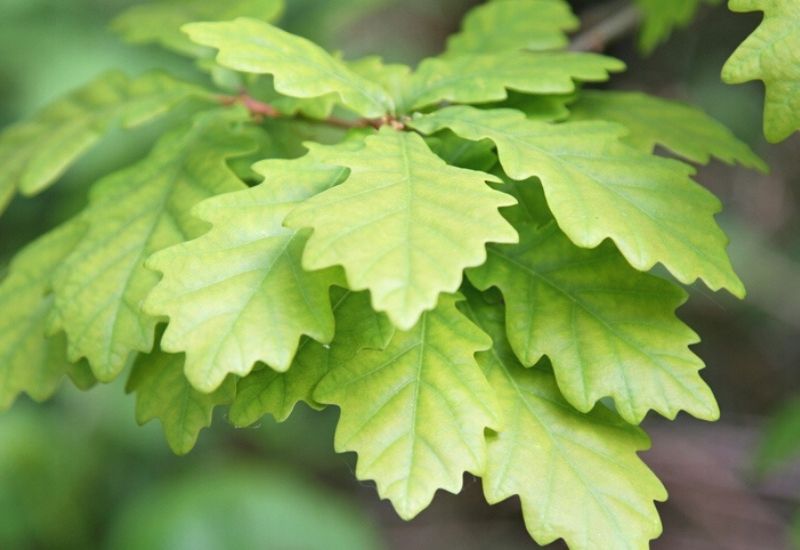
Perhaps you already have an oak tree on your property. In that case, you are likely wondering how you can identify exactly what kind of oak it is.
The best way to identify oaks is by the following three parts of the plant.
The fruit of an oak tree is an acorn. Acorns are able to sprout new oak trees after they fall to the ground. Acorns are nuts that typically have a cap. The cap is the part that attaches to the oak tree branch. Different oak species have acorns with different sizes, shapes, and textures. This is often one of the most reliable ways to differentiate between some oak species.
A quintessential oak leaf is deciduous with multiple lobes. Variation in lobe number and shape is another clue as to what oak you are looking at.
While far from noticeable, oaks do have flowers. The male flowers are more noticeable. These take the form of dangling catkin that appear in spring.
Female flowers are even more conspicuous. These flowers are smaller and grow later in the season. They are often nestled close to the buds of the current year's growth.
19 Types of Oak Trees For Your Landscape
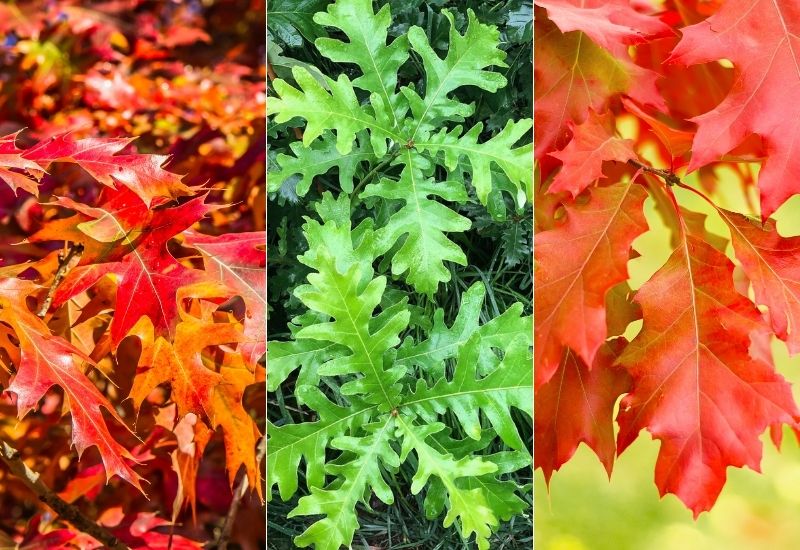
Now that you know some general facts about oaks, read more to learn what makes each species different. Individual oak species also have different levels of popularity.
This is based on the preferences people have for different growth habits, leaf shapes, and overall appearances among oak trees.
Before choosing the right oak for you, you must be able to distinguish one oak from another. After that, you can accurately select the one that is best for you and for your landscape. Here are 19 of the best types of oak trees you can choose from.
1: Quercus Alba (White Oak)
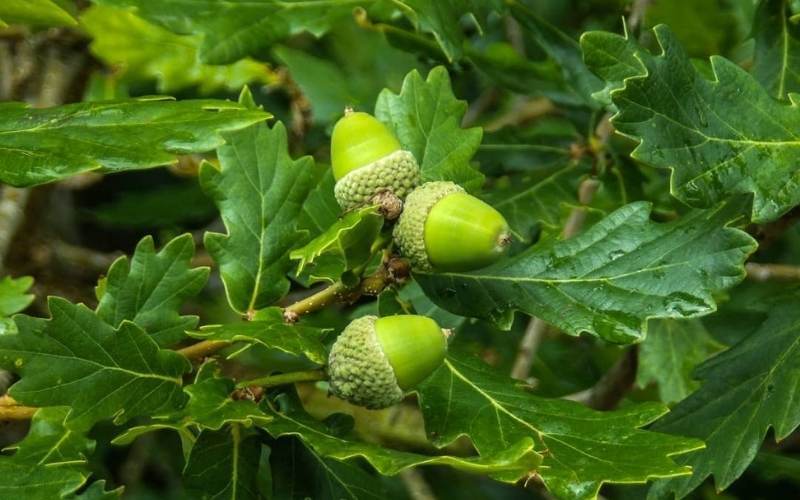
Although it grows slowly, the mature form of white oak is nothing short of majestic. As it reaches extreme heights, its spread rose to match that height. The wide-reaching branches provide ample shade below.
Along these branches are the white oak leaves grow with their signature rounded lobes. These lobes appear in sets of seven on each leaf.
In fall, the leaves turn to a deep crimson color. Many oaks are not known for fall color. But this tree is definitely an exception.
White oak acorns are about one inch long. They grow individually or in pairs. The caps cover about ¼ of the total acorn.
White oak needs full sun and moist acidic soil. Even in the best conditions, this tree is a slow grower. But white oak is well worth the wait as its massive mature rounded form supplies unmatched beauty.
Quercus Rubra (Red Oak)
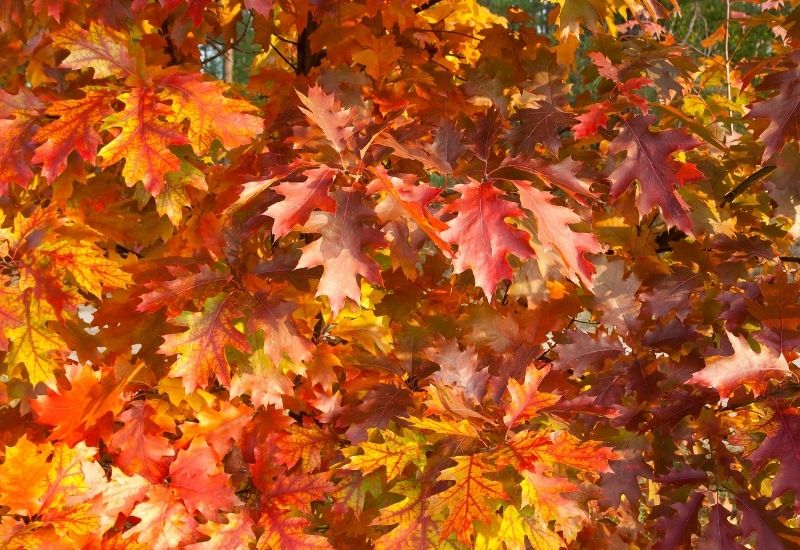
In many regions of the United States, red oak is a main feature of the forest. It grows in abundance throughout the woodlands of the eastern half of the country.
The leaves of red oak exemplify the contrast between white and red oaks. These leaves have seven to 11 loved which are pointed.
The bark of red oak shows typically shows both brown and grey coloration. At maturity, this bark consists of wide ridges that are flat-topped and grey. They are separated by shallow groves.
Red oak has a relatively fast growth rate. This is not a common trait among oaks. But, red oak is one of a few exceptions.
Plant this tree in soil with medium moisture in areas of full sun. Lower ph soils are best for red oaks.
As a native tree, red oak makes massive contributions to its ecosystem. Without this large deciduous tree, the forests of the united states would have an entirely different character.
Quercus Velutina (Black Oak)
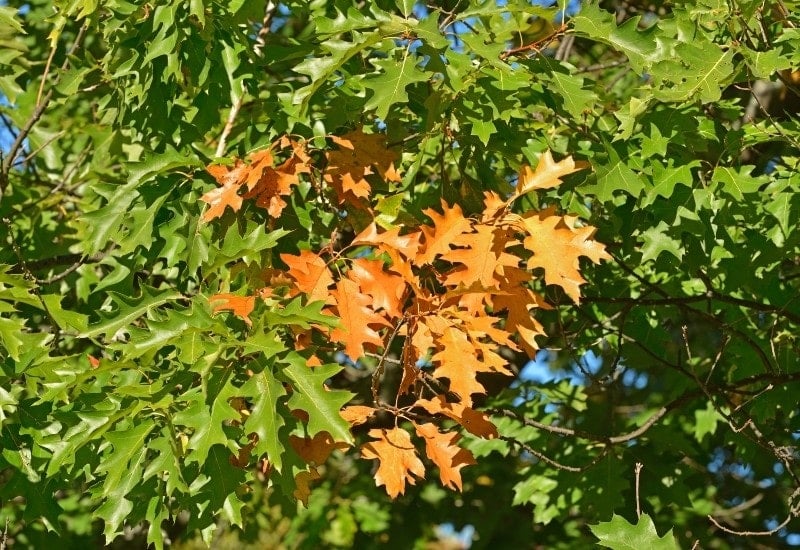
Black oaks share an extremely similar appearance with red oaks. But there are a few subtle differences that will help you with identification.
First, black oak is slightly smaller and can tolerate dryer soils. While similarly lobed, black oak leaves tend to be darker and glossier.
Still, it remains difficult to recognize these differences right away. The bark and acorns may be a bit more helpful when trying to distinguish black oak from red oak.
Red oak and black oak acorns are both around ¾" in length. But, the caps are quite different.
Red oak acorn caps cover about ¼ of the acorn. Black oak acorns can cover more than half of the acorn.
Black oak bark is also a key identifying feature. This back is nearly black at maturity and features deep fissures and ridges. The ridges are separated by frequent horizontal cracks.
While challenging to identify, black oak is a lovely native deciduous shade tree.
Quercus Palustris (Pin Oak)
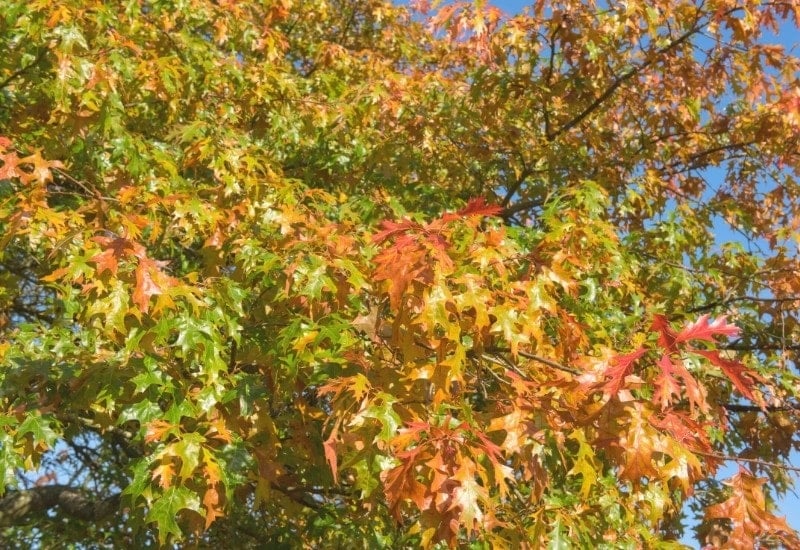
Pin oak is another generous shade-giving oak tree. However, this tree is far more likely to grow in urban settings rather than living exclusively in woodlands.
Because of its tolerance for pollution and poor soils, pin oak is popular as a street tree. It also commonly grows in parks, golf courses, and college campuses.
Pin oak has an interesting branching habit. The mid-tier branches grow straight out at a 90-degree angle from the trunk. The upper branches grow in an upward direction. The lower branches often droop downward.
Interestingly, the leaves have a tendency to adhere to this pattern. These leaves are a bit thinner than other oak leaves. The pointed middle lobes often grow out at a right angle much like the mid-level branches.
It is common for pin oak to experience chlorosis. This results from alkaline soils and causes the leaves to turn yellow.
Despite this common problem, pin oak is one of the most popular oak trees. Plant in full sun with ample soil moisture. Then sit back and enjoy the shade and unique growth habit of pin oak for years to come.
Quercus Bicolor (Swamp White Oak)
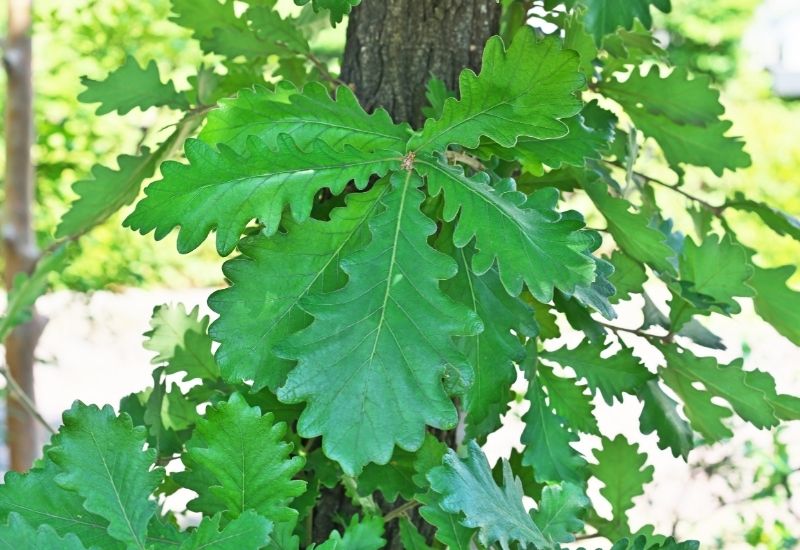
Swamp white oak is an intriguing variation on the typical white oak. This tree thrives in moist soils which gives it its common name.
Regarding physical characteristics, there are a few that set swamp white oak apart from its relatives.
The first relates to its overall form. Swamp white oaks are just as large and spreading as white oaks. However, their branches offer a different effect.
These far-reaching branches often sprout a higher number of secondary branches. At times, the lower branches form a large arch that curves back towards the ground.
The leaves feature rounded lobes. But the separation between lobes is quite shallow.
Swamp white oak grows best in acidic soils in full sun. It is deciduous and usually lives in low-lying areas where water gathers.
Quercus Robur (English Oak)
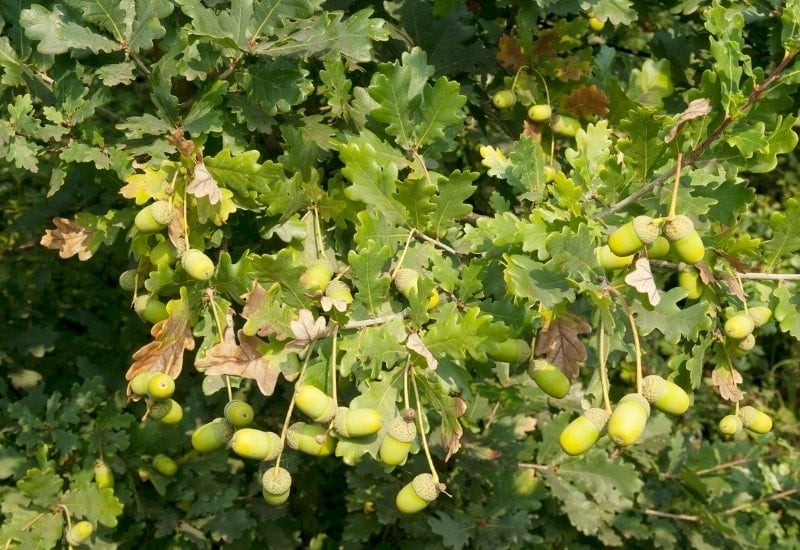
English oak is native to Europe and western parts of Asia. In England, it is one of the primary sources of timber.
This oak tree looks a lot like white oak. Its leaves have a similar shape and a similar number of rounded lobes.
The acorns are an important identification trait for this tree. These acorns are elongated compared to other oak trees. The cap covers about 1/3 of these oblong fruits.
This tree typically as branches that grow from the lower portion of the trunk even at maturity. This gives the trunk a short appearance.
The bark on that trunk is dark grey or even black at the time. It has many ridges and fissures.
Overall, the form is broad and rounded. In addition, English oak can grow to be very large. Some specimens even grow taller than 130 feet.
In general, this tree is low maintenance. However, it can have some problems with powdery mildew.
Quercus Coccinea (Scarlet Oak)
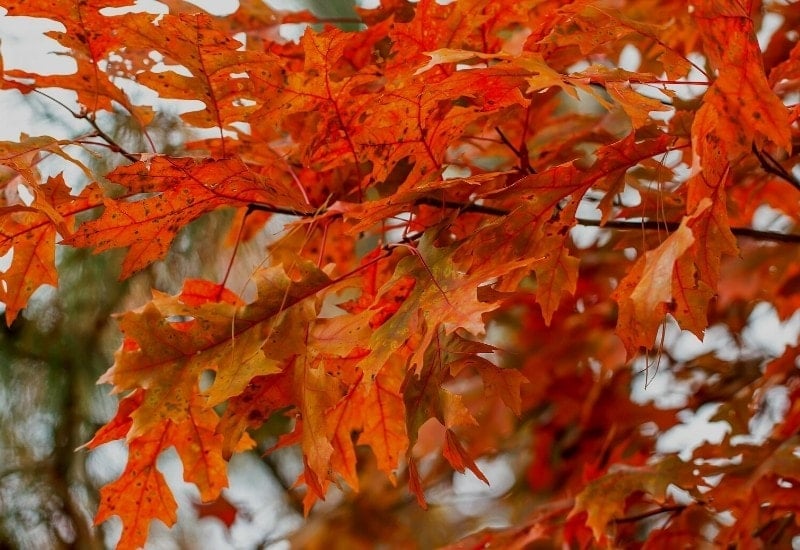
As you might expect, scarlet oak offers deep red fall color. In some cases, this coloration can be inconsistent. But, this red is often so vibrant it rivals some more popular autumn trees like red maple.
But this no reason to ignore this tree. In fact, the leaf color is appealing even in the summer months. At that time, the tops of the leaves are a rich glossy green color.
The form of the leaves is thin like the pink oak and also has pointed lobes. Each leaf has seven to nine lobes and each lobe has a bristly tip.
A mature scarlet oak has a form that is rounded and open. It often reaches 50-70 feet tall with a slightly smaller spread.
Scarlet oak grows best in acidic soil that is also somewhat dry. Plant this oak if you are interested in a large shade tree with striking fall colors.
Quercus Virginiana (Live Oak)
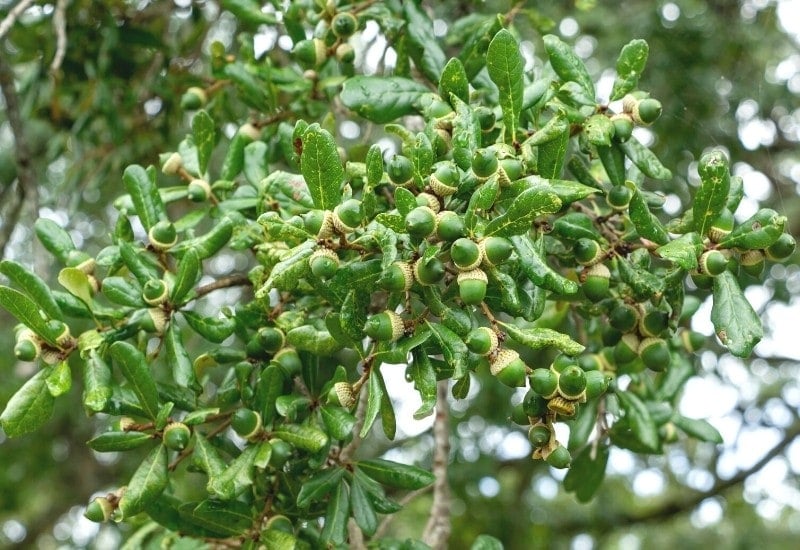
Live oak grows in warmer regions of the United States. In the south, it is a main component of large estates and former plantations.
If you ever see a live oak, it quickly becomes apparent why people plant this tree so often. It is a large shade tree with a spread that can exceed, and even double the height.
Another unique aspect of this oak is that it is evergreen while many other oaks are deciduous. The leaves also have a shape that differs from what most people think of when they imagine oak leaves.
Live oak leaves are simple elongated ovals. They are about one to three inches long. To add to their differences from other oaks, they are also evergreen.
While planting this tree in a small area is ill-advised, this tree is a great option for large areas zones eight to ten.
Live oak will grow best in full sun with moist soils. In its most attractive form, you will find mature live oaks with spreading branches covered in Spanish moss.
Quercus Laurifolia (Laurel Oak)
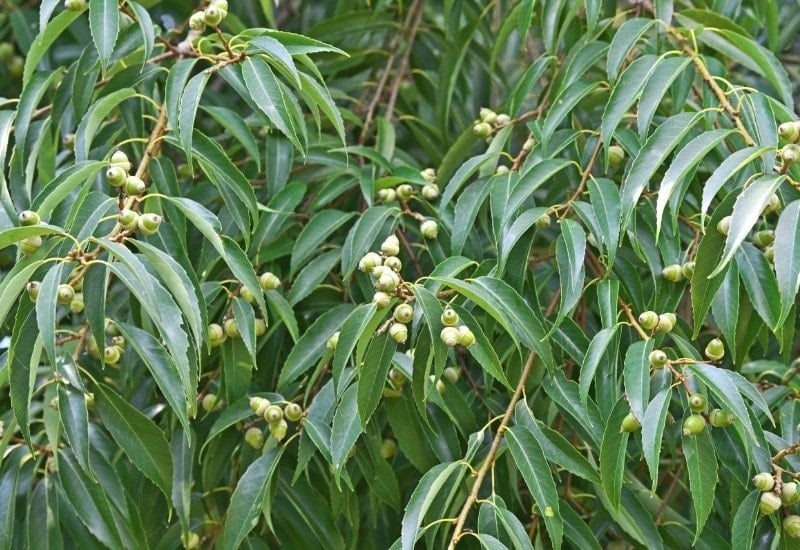
Laurel oak is an interesting tree because it has both evergreen and deciduous characteristics. While the leaves do eventually fall, this does not occur until late in February. This gives laurel oak the appearance of an evergreen for much of the winter.
This species is native to the southeastern part of the United States. It is another large shade tree with a height and spread that match each other.
The leaves of laurel oak are reminiscent of laurel shrubs. They have an elongated elliptic shape with mostly smooth margins. Their color is often dark green
Laurel oak thrives in acidic soils. In its native range, it inhabits warm coastal areas. The further north this tree grows, the more deciduous it becomes.
Plant this tree if you are in a warmer region and you want an oak that stands out from the rest.
Quercus Montana (Chestnut Oak)
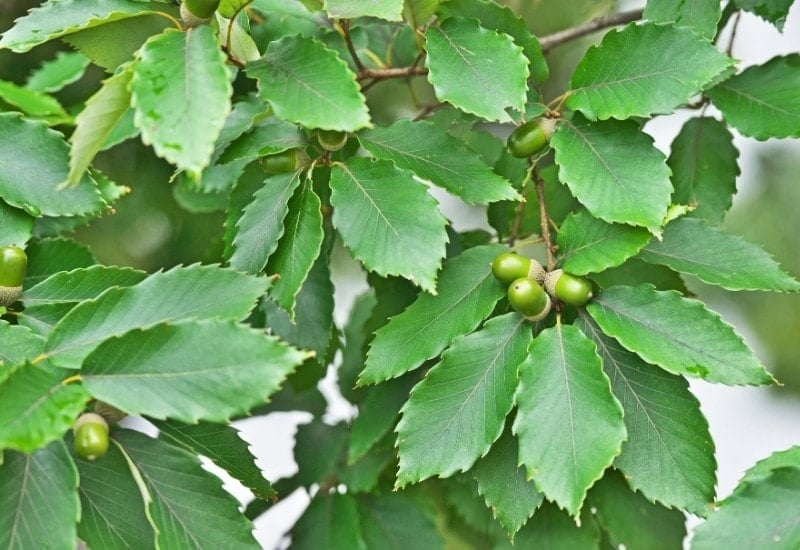
In the wild, chestnut oak inhabits rocky areas at higher elevations. It is native to the eastern United States.
This tree is deciduous. It has a broad rounded form. Because of its adaptability to dry soils, it sometimes carries the name rock oak.
The name chestnut oak comes from the fact that it shares some visual characteristics with chestnut trees. The most notable of these is the bark which is brown with a corklike texture.
The leaves of chestnut oak are different than most oaks. These leaves are obovate with coarse serration. They look similar in shape to some beech trees.
Despite adapting to poor soils, this tree can have numerous diseases. Among these are root rot, cankers, powdery mildew, and even chestnut blight.
But if you can avoid these problems, chestnut oak is a good shade tree option for well-drained soils.
Quercus Prinoides (Dwarf Chestnut Oak)
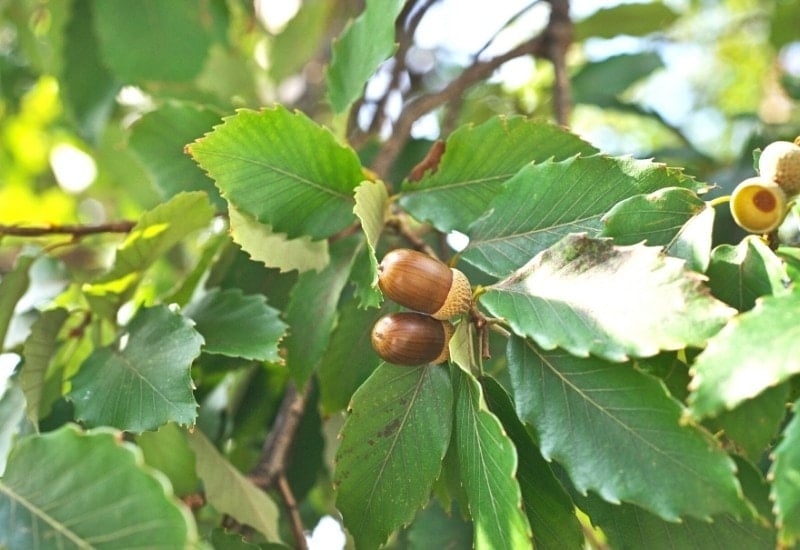
Dwarf chestnut oak grows as a large shrub or as a small tree. It averages about 15' feet in height and spread at maturity.
Many oaks have a bitter taste to their acorns. This bitterness is far less present in the acorns of dwarf chestnut oak. This results in a flavor that is far more favorable to wildlife.
Dwarf chestnut oak leaves are remarkably similar to chestnut oak leaves. This native shrub also has a deep taproot. This characteristic makes transplanting a significant challenge.
Dwarf chestnut oak can adapt to some dry soils although this is not its preference. It is also tolerant of limited amounts of shade.
Quercus Gambelii (Gambel Oak)
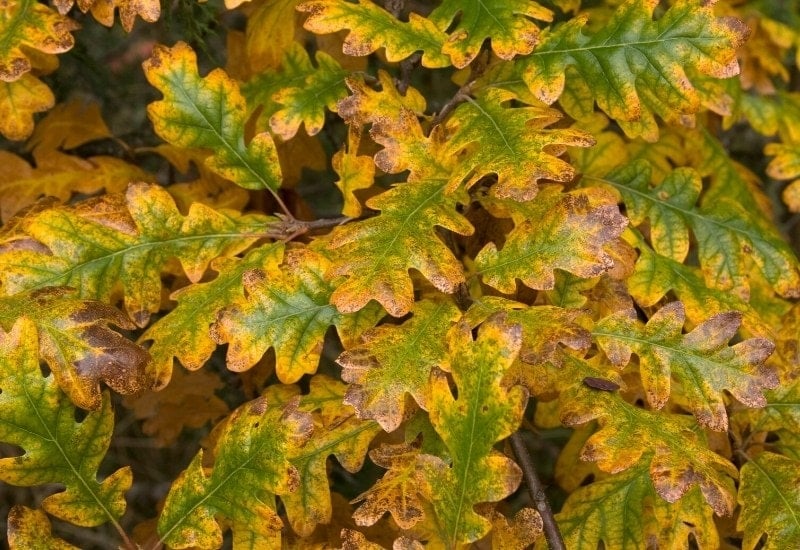
Gambel oak another variety of oak that is on the smaller side. While not a true shrub, this small tree only grows to an average mature height of 30 feet at most.
The plant has a rounded form throughout its long life span which can reach 150 years. In older age, it takes on a weeping form that requires plenty of space.
Gambel oak is valuable for its ability to adapt to both moist and dry soils. Its leaves are deciduous with rounded lobes.
Another notable feature of this plant is its high production of acorns in the fall. These serve as a food source for animals in winter.
Quercus Nigra (Water Oak)
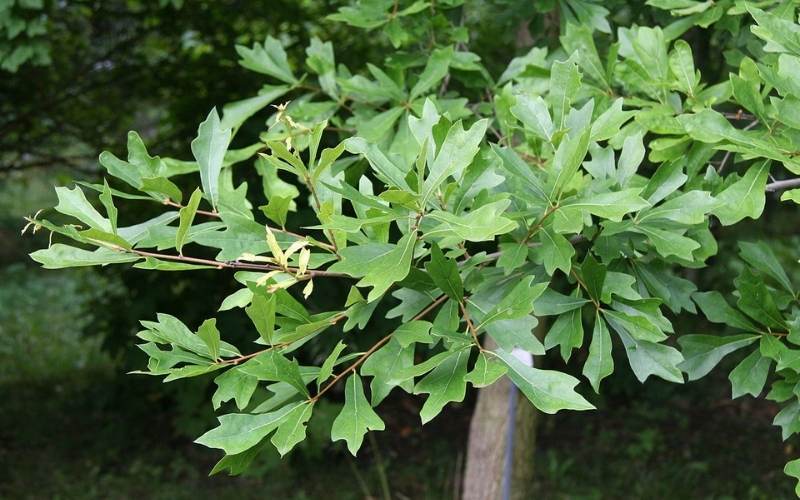
Water oak is a species native to the southeast United States. It grows naturally near streams as the name implies.
This tree is semi-evergreen. Old leaves fall in the winter. However, in some cases, they will persist through the winter.
The shape of the leaves is unlike any other oak. They have a narrow oval shape. That shape is consistent from the petiole to the midpoint of the leaf.
The beyond that mid-point, three subtle rounded lobes give a wavy shape to the outer half of the leaf. The leave color is green with some hints of blue.
Like many oaks, water oak has a broad rounded canopy. The trunk can be exceptionally thick. At times it will be around five feet in diameter.
Even though this tree has a sturdy appearance, it is actually weak wooded. Be careful about planting this tree near your house. The branches are prone to breaking especially when carrying any sort of extra weight.
Quercus Macrocarpa (Bur Oak)
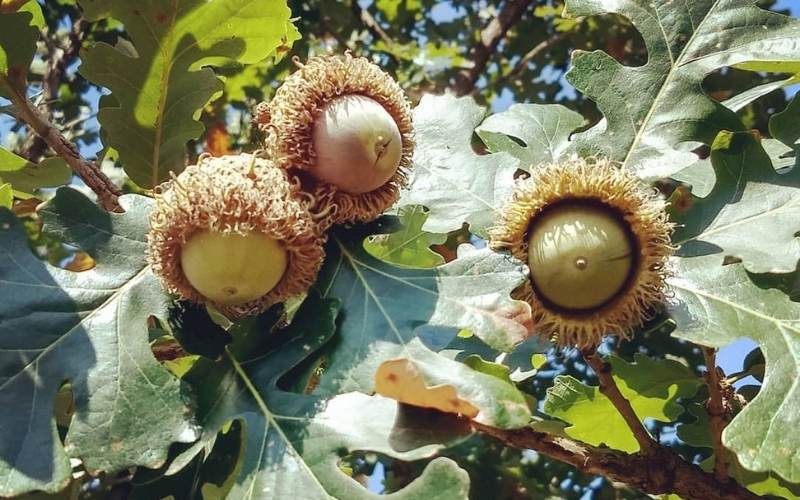
As you may have noticed, bur oak is one of the few trees on this list with a preference for alkaline soils. This preference is s slight but explains why bur oak so often grows where limestone is nearby.
But oak is a prominent native plant in prairie regions of the central United States. In youth, it has an oval or pyramidal for. As it grows it becomes more open and rounded.
The leaves have an odd shape as well. They are far wider at the ends compared to the base with is narrow. Both halves of the leaf have rounded lobes.
The acorns have a strange appearance too. These acorns are nearly entirely covered by the cap. The cap itself is heavily fringed giving a fuzzy appearance.
Bur oak is vulnerable to many different diseases. But as long as it does not contract one of these numerous diseases, it is low maintenance and a great addition to large lawn spaces.
Quercus Falcata (Spanish Oak)
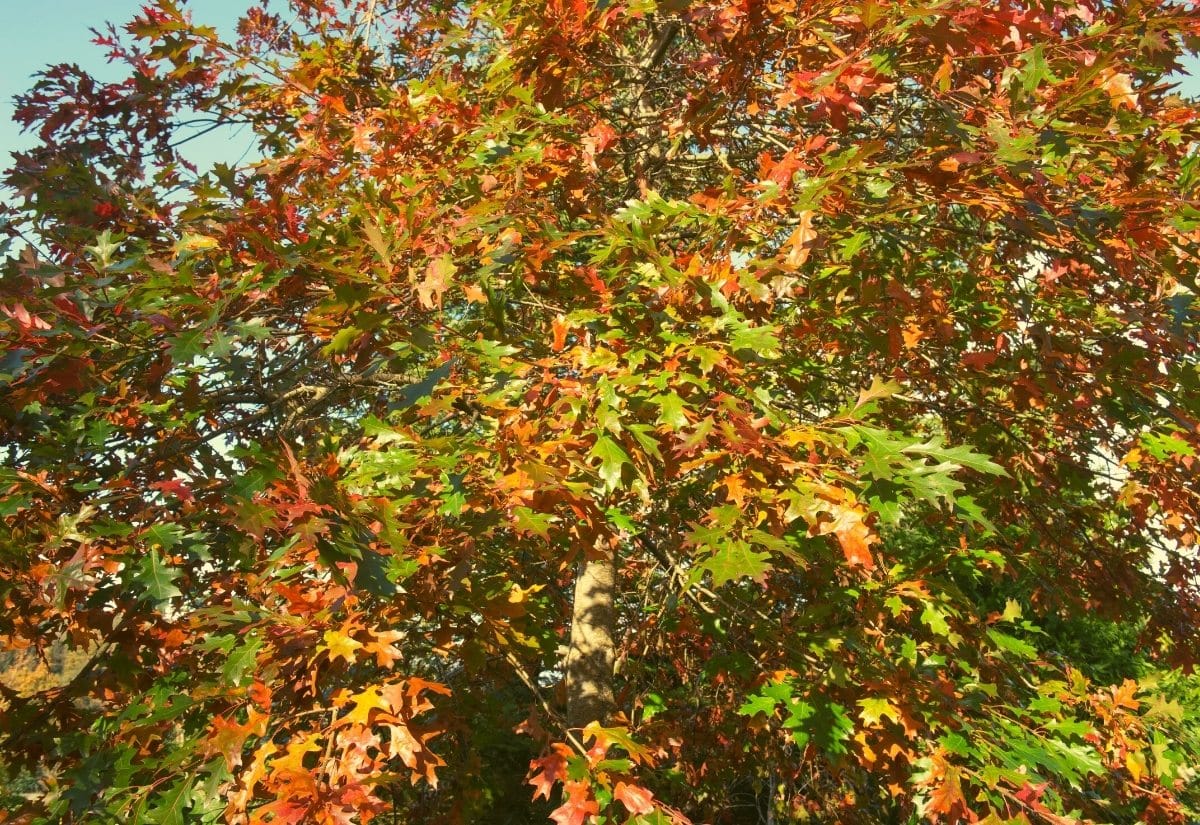
Spanish oak is a deciduous oak variety that also goes by the name southern red oak. But don't expect to see much red on this tree.
Rather than turning a pleasing shade of red in fall, instead, the leaves simply turn brown. While this fall color is disappointing, there is plenty of aesthetic value in this tree.
A sturdy strait trunk supports an open crown. The canopy consists of leaves with an intriguing shape.
That shape includes a rounded base and three trident-like lobes at the outer end of the leaf. The middle lobe is often the longest but the leaf shape overall shows variation.
Spanish oak is most likely to grow in upland regions in the American south. At the time, it ventures down into valleys as well.
If you plant this tree, provide full sun and acidic soil. While well-drained soil is best, this tree can survive some temporary flooding. However, the root system is known to be quite sensitive to damage. Plant near any construction area is a significant risk.
Quercus Stellata (Post Oak)
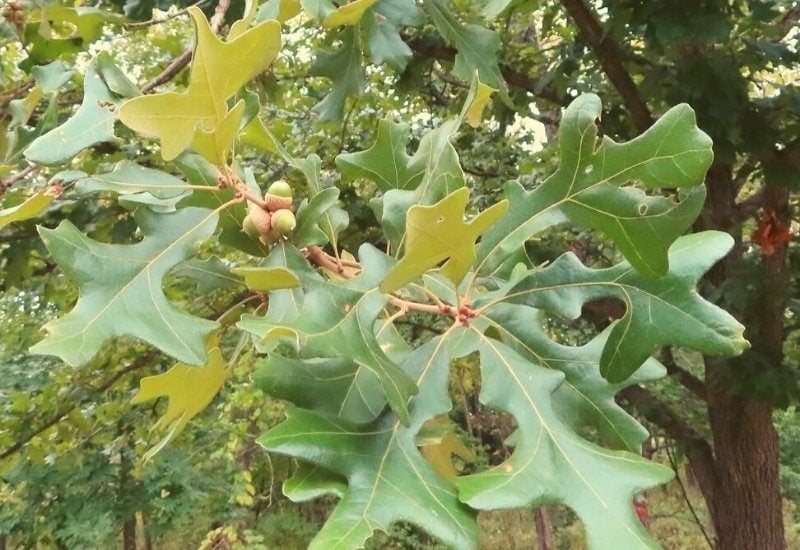
Compared to many other oak species, post oak is generally smaller. But remember that this is all relative.
Post oak is still suitable as a shade tree as it can reach 50feet in height and spread.
This tree has a preference for moist acidic soils. But don't think that they are limited to areas with those characteristics. Instead, post oak is very adaptable when it comes to soil types.
For example, post oak can survive in exceptionally dry soil in many cases. Because of this, post oak often grows on mountain slopes where the soil is rocky and drains quickly.
In keeping with the oak stereotype, post oak has useful hard wood. The fact that this tree is often used to create fence posts is the inspiration for the common name.
Quercus Phellos (Willow Oak)
When you see the leaves of willow oak, it is no surprise that it carries that name. While part of the oak family, the foliage of willow oak bears little to no resemblance to other oaks. Instead, it is nearly identical to the foliage f common willow trees.
To add further contrast to common oak species, willow oak Is a fast-growing tree. When growing in the wet low-lying areas it calls home, this tree races towards its mature size.
At maturity, this oak is narrower than others. Rather than having a perfectly-rounded canopy, willow oak is just a little more than half as wide as it is tall.
Willow oak leaves often turn gold or brown in the fall. They also carry acorns that are an important food source for animals in the American southeast.
Beware that this oak can have numerous diseases including oak wilt, oak skeletonizer, and much more. Despite this, willow oak is usually long-lived and a great option for planting along with ponds and other natural water features.
Quercus Ilex (Holm Oak)
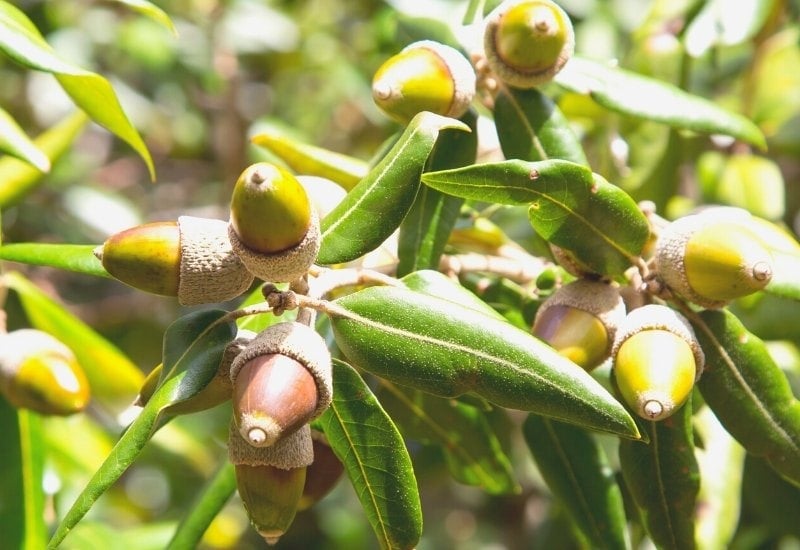
Holm oak is one of the rarer broadleaf evergreen oaks. The leaves on this tree are dark green with sharp edges like a holly shrub. In size, they are about one inch wide and three inches long.
Holm oak is native to the Mediterranean region. As such, it survives only in warmer regions. These include zones 7-10.
Overall, the form of holm oak is large and rounded. Its foliage is dense and grows on branches that are generally upright in their growth habit.
A textured cup covers about half of the acorn. These acorns tend to ripen in the early fall.
If you are in a warmer region, holm oak is a great evergreen tree option for you.
Conclusion
Oaks trees deserve the popularity they've achieved. The genus plays a vital role in forest ecosystems throughout North America. Oaks are also attractive. You can't help but admire the scale of these trees at maturity.
From afar, wide oak canopies add rounded forms to the landscape. Beneath those dignified branches, you will find the relief of cool shade on hot summer days.

John Haryasz is a writer with a background in landscape architecture. His education includes a Bachelor of Science in landscape architecture from UMass, Amherst with a minor in psychology. Following graduation, John worked in a small landscape architecture office. In this role, he led many successful projects in Berkshire County, MA. After a few years, John began offering freelance design services. He has since produced designs for projects across the country. As a writer, John aims to share knowledge while promoting engagement with the outdoor world.
Source: https://www.gardeningchores.com/types-of-oak-trees/
0 Response to "Drawings of Oak Trees in the Fall"
Post a Comment